144 - Cardial Incompetence and Associated Gastroesophageal Reflux
Editors: Shields, Thomas W.; LoCicero, Joseph; Ponn, Ronald B.; Rusch, Valerie W.
Title: General Thoracic Surgery, 6th Edition
Copyright 2005 Lippincott Williams & Wilkins
> Table of Contents > Volume II > The Mediastinum > Section XXVIII - Mediastinal Infections, Overview of Mass Lesions in the Mediastinum, and Control of Vascular Obstructing Symptomatology > Chapter 169 - Vascular Masses of the Mediastinum
function show_scrollbar() {}
Chapter 169
Vascular Masses of the Mediastinum
Alberto de Hoyos
Ali Dodge-Khatami
Carl L. Backer
Mediastinal lesions of vascular origin according to Lyons and associates (1959) are responsible for approximately 10% of mediastinal masses. Vascular masses of the mediastinum may be categorized according to one of several methods. They could be classified according to the compartments of the mediastinum from which they arise: anterior, visceral, and paravertebral. However, because most vascular masses originate in the visceral compartment, a more useful subdivision of mediastinal masses of vascular origin has been suggested by Kelley and associates (1978). They classified these vascular masses as arising from either the pulmonary or systemic circulation and as being either arterial or venous in origin: systemic venous system, pulmonary arterial system, pulmonary venous system, and systemic arterial system.
From a practical standpoint, however, most masses, as noted by Cole and colleagues (1995) are initially recognized as abnormalities on chest radiographics. Bousmara and co-workers (1992) suggest that a differential diagnosis may be established by considering the radiographic region involved and the possible vascular structures contained therein or nearby (Table 169-1). Confirmation of the diagnosis is usually made by contrast-enhanced computed tomography (CT), magnetic resonance (MR) imaging, or echocardiography. McAdams and associates (2003) and Gilkeson and Kolodny (2003) have demonstrated the value of these studies in the diagnosis of mediastinal hemangiomas and lesions of the aorta, respectively. For patients with complex lesions, and patients with concomitant cardiac abnormalities, biplane cardiac cine-angiograms are often necessary.
SYSTEMIC VENOUS SYSTEM
Anomalies of the systemic venous system causing a mediastinal vascular mass include aneurysms of the innominate vein and superior vena cava, dilatation of the superior vena cava associated with partial anomalous venous return, persistent left superior vena cava, and azygos or hemiazygos enlargement. The diagnosis of these lesions is often suggested by plain radiographs, but frequently CT angiography or MR venography is necessary for confirmation as reported by Hartnell (1993) and Hartnell and colleagues (1995), as well as by White (2000). Conventional angiography is now rarely necessary.
Vena Cava and Tributaries
The great majority of cases of dilatation of the superior vena cava are the result of elevated central venous pressure, commonly from cardiac decompensation and less often from tricuspid stenosis or cardiac tamponade secondary to pericardial effusion or constrictive pericarditis. Other common causes are listed in Table 169-2. The radiographic appearance is distinctive and consists of a smooth, well-defined widening of the right side of the mediastinum. The azygos vein is almost always dilated as well, a finding that is a more dependable sign of systemic venous hypertension because the diameter of the vein in the right tracheobronchial angle can be precisely measured. Rarely, the superior vena cava has an aneurysmal dilatation (Fig. 169-1). Abbott (1950) reported the first case. There are other infrequent reports in the literature as noted by Bell and co-workers (1970). Joseph and colleagues (1989) reported the association of cystic hygroma of the mediastinum with cervical and thoracic venous aneurysms. Eight of 15 patients with mediastinal cystic hygroma were found to have abnormal enlargement of neck or thoracic veins. Five of these children had aneurysmal dilatation of the superior vena cava. Diagnosis is usually established with contrast-enhanced CT. Occasionally, the inferior vena cava can also undergo localized aneurysmal dilatation and be visible as a smooth, sharply circumscribed opacity in the right cardiophrenic angle.
More common than an aneurysm of the superior vena cava is dilatation of the superior vena cava from partial anomalous pulmonary venous return from the right lung to the superior vena cava. Generally, this occurs with a subcaval
P.2524
atrial septal defect and is referred to as a sinus venosus atrial septal defect. The right upper and middle lobe pulmonary veins (right superior pulmonary vein) drain into the lower portion of the superior vena cava or the superior vena caval right atrial junction.
Table 169-1. Vascular Lesions of the Mediastinum Based on Chest Radiographs | |||||||||||||||||||||||||||||||||||||
|---|---|---|---|---|---|---|---|---|---|---|---|---|---|---|---|---|---|---|---|---|---|---|---|---|---|---|---|---|---|---|---|---|---|---|---|---|---|
|
Persistence of the left superior vena cava is an uncommon anomaly that occurs in 0.3% of normal subjects and in about 4.4% of patients with congenital heart disease as reported by Cha and Khoury (1972). Most patients with this anomaly have both a right and a left superior vena cava. Occasionally, a persistent brachiocephalic vein connects the two superior vena cavae. Persistence of the left superior vena cava may present on the chest radiograph as a widening of the aortic shadow, a paramediastinal bulge, or as a paramediastinal strip or crescent along the upper left cardiac border according to Cormier and colleagues (1989). It results from persistence of the left anterior and common cardinal vein and the left sinus horn. Although the diagnosis of this anomalous vessel may be suggested from plain radiographic findings, White and associates (1997) record that CT and MR imaging are virtually diagnostic. On CT, the left superior vena cava is seen as a round density just to the left of the aortic arch. If contrast material is administered via the left arm, the vein enhances (Fig. 169-2). A persistent left superior vena cava extends inferiorly to the region of the left superior pulmonary vein and then connects into the coronary sinus and has no physiologic effect. Rarely, the vein may connect into the left atrium, giving rise to a small right-to-left shunt. However, it can also be associated with the unroofed coronary sinus syndrome and cause a large right-to-left shunt as noted by Quaegebeur and co-workers (1979). The shadow created by an anomalous left superior vena cava can be simulated by that caused by anomalous venous drainage of the left upper lobe.
Table 169-2. Dilatation of the Superior Vena Cava | |
|---|---|
|
Aneurysms of the innominate vein are rare. They originate in the visceral compartment, but project into the anterior compartment on a lateral chest film. On the left side of the mediastinum this may overlie the aortic knob and give the appearance of a double aortic knob, which also may be caused by pseudocoarctation of the aorta, from which it must be differentiated.
Enlargement of the azygos vein can mimic a right paratracheal mass or enlarged lymph nodes (Fig. 169-3). Heitzman (1973) defined an enlarged azygos vein as one that is perpendicular to the right main-stem bronchus and measures greater than 7 mm. There are many causes of dilatation of the azygos and hemiazygos veins: (a) portal hypertension, (b) anomalous pulmonary venous drainage, (c) acquired obstruction of the superior or inferior vena cava, (d) azygos continuation of the inferior vena cava, (e) persistence of the left superior vena cava, and (f) hepatic vein obstruction. The most common cause, however, is elevated central venous pressure as a result of cardiac decompensation, tricuspid valvular lesions, acute pericardial tamponade, or constrictive pericarditis (Table 169-3).
Radiographically, dilatation of the azygos vein is evidenced by a round or oval shadow in the right tracheobronchial angle greater than 10 mm in diameter in the erect position and greater than 14 mm in the supine position.
P.2525
Measurements exceeding these figures indicate an increase in either pressure or flow.
 |
Fig. 169-1. A. Chest radiograph of a 10-year-old boy who underwent perinatal resection of a cystic hygroma. The superior mediastinal widening is from an aneurysm of the superior vena cava (SVC). B. Computed tomography of the same patient shows a massively enlarged SVC filled with contrast. This SVC was 2.43 times the size of the aorta. C. Magnetic resonance imaging demonstrates an SVC aneurysm without requiring intravenous contrast. |
In plain chest radiographs a dilated azygos vein can be differentiated from an enlarged azygos lymph node fairly easily by comparing the diameter of the shadow on radiographs exposed in the erect and supine positions. When the vein is responsible, there is a noticeable difference in size. When the nature of the shadow is in doubt, CT provides definitive information. Similarly, the CT appearance of azygos and hemiazygos continuation of the inferior vena cava is so characteristic that angiography is seldom indicated for diagnosis as noted by Dudiak (1989, 1991) and Webb (1982)
P.2526
and their associates. In this condition, venous blood from the lower extremities and abdomen is diverted into the azygos, or less commonly, the hemiazygos, resulting in dilatation of these veins. Chest radiographs usually show an enlarged azygos vein and a widened paraspinal reflection, and the inferior vena cava is usually not visualized on the lateral film. CT or MR imaging shows enlargement of the azygos or hemiazygos veins and marked dilatation of the azygos arch or the left supreme intercostal vein (Fig. 169-4). Azygos continuation of the inferior vena cava is characterized by a candy-stick appearance of the dilated azygos vein on venography, but contrast-enhanced CT or MR imaging is usually diagnostic. This anomaly is often associated with a congenital cardiac malformation, with errors in abdominal situs, or with asplenia or polysplenia. Most patients are asymptomatic. Of 32 cases reviewed by Anderson and colleagues (1961), situs was normal in 18 and abnormal in 14. The accessory hemiazygos vein on the left side may enlarge in a fashion analogous to the azygos vein on the right side. Dilatation of the left supreme intercostal vein generally possesses the same etiologic significance as that of dilatation of the azygos vein, although radiographic visualization of this vein is not nearly as frequent as that of the azygos vein. The normal left supreme intercostal vein originates from the confluence of the second, third, and fourth left intercostal veins. As it passes anteriorly from the spine, it relates intimately to some portion of the aortic arch. In this location it may be confused with a persistent left superior vena cava. The supreme intercostal vein connects the left brachiocephalic vein with the hemiazygos system. It runs parallel to the aortic arch, and normally measures no more than 4 mm in diameter. As noted by Haswell and Berrigan (1976) it can become dilated (Fig. 169-5), and in this location it is seen end-on as the aortic nipple, a local protuberance that is identifiable in about 10% of normal subjects. On erect posteroanterior radiographs, the maximum diameter of the aortic nipple in normal subjects is 4.5 mm. A diameter greater than this is a useful sign of circulatory abnormalities, the most common of which is cardiac decompensation; other causes include (a) congenital or acquired obstruction of the vena cava such as in azygos continuation of the inferior vena cava, (b) hypoplasia of the left innominate vein, (c) portal hypertension,
P.2527
(d) Budd-Chiari syndrome, (e) obstruction of the inferior vena cava, and (f) congenital absence of the azygos vein. Hemiazygos continuation of the inferior vena cava is particularly associated with the heterotaxy syndrome polysplenia, as shown by Freedom and Treves (1973).
 |
Fig. 169-2. A. Computed tomography of the chest showing bilateral superior vena cavae. The left superior vena cava is seen as a round density just to the left of the left subclavian artery. B. In a more caudal cut, the superior vena cava is shown to the left of the aortic arch. |
 |
Fig. 169-3. A. Chest radiograph demonstrating a prominent azygos vein just superior to the right tracheobronchial angle. B. Computed tomography of the chest shows a prominent azygos vein to the right of the trachea. |
Table 169-3. Enlarged Azygos Vein | ||||||||||||
|---|---|---|---|---|---|---|---|---|---|---|---|---|
|
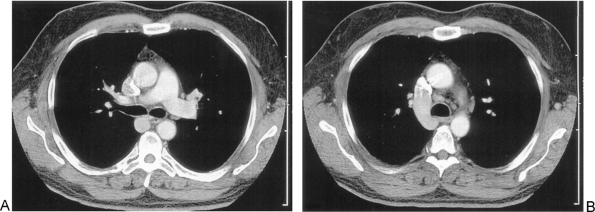 |
Fig. 169-4. A. Computed tomography of the chest demonstrating a dilated azygos vein posterior to the carina. B. Computed tomography of the chest demonstrates the azygos continuation of the inferior vena cava as a prominent vascular structure to the right of the trachea. |
Other abnormalities of the azygos vein include a diverticulum, which was described by Caramutti and co-workers (2000), and aneurysm formation, as noted by Seebauer and associates (1989).
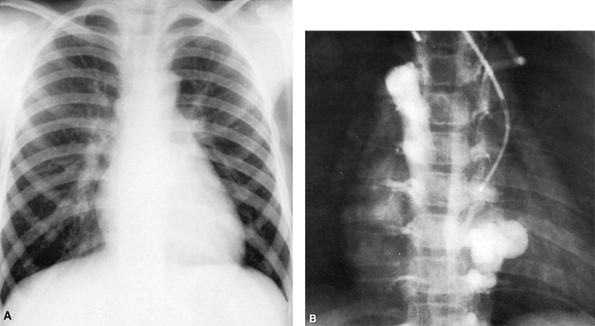 |
Fig. 169-5. A. Chest radiograph of a 9-year-old boy with a paravertebral arteriovenous fistula causing prominent filling of both the azygos vein and the highest intercostal vein (aortic nipple). B. Angiogram of a dilatated, tortuous fistula. The veins fill during the arterial phase. Both the azygos and highest intercostal veins are prominent. |
PULMONARY ARTERIAL SYSTEM
Major Pulmonary Arteries
The main pulmonary artery may be so greatly dilated as to suggest a mediastinal mass. Anomalies of the pulmonary arterial system causing a mediastinal vascular mass include (a) enlarged pulmonary artery secondary to a large left-to-right intracardiac shunt; (b) poststenotic dilatation of the
P.2528
pulmonary artery from pulmonary valve stenosis; (c) tetralogy of Fallot with absent pulmonary valve; (d) Eisenmenger's complex; (e) ductus aneurysm; (f) pulmonary artery sling; (g) patches following tetralogy repair; (h) aneurysms caused by systemic-to-pulmonary artery shunts; (i) aneurysms of the main pulmonary artery or right ventricular outflow tract; (j) pulmonary artery dissection; (k) distention of the pulmonary artery by thrombus, embolus, or tumor; and (l) pulmonary artery aneurysms due to infective endocarditis (Table 169-4). The latter cause (infective endocarditis) was described by Bozkurt and colleagues (2003).
Table 169-4. Dilatation of the Main Pulmonary Artery | |
|---|---|
|
Most congenital anomalies causing a vascular mediastinal mass associated with the pulmonary arterial tree are related to abnormalities of the pulmonary valve or intracardiac shunts. Surgical systemic-to-pulmonary artery shunts and other surgical procedures can also cause vascular masses related to the pulmonary artery. Large left-to-right shunts from an atrial or ventricular septal defect will initially cause enlargement of the proximal main pulmonary artery. The chest radiograph will show an enlarged heart and enlarged main pulmonary artery as a bulge adjacent to the aortic knob with obliteration of the aortopulmonary window, and will suggest the presence of increased pulmonary blood flow (Fig. 169-6). As the pulmonary vascular resistance increases, the amount of pulmonary blood flow diminishes and the lung fields become dark, with the proximal pulmonary artery remaining large (Eisenmenger's complex) as described by Wood (1959).
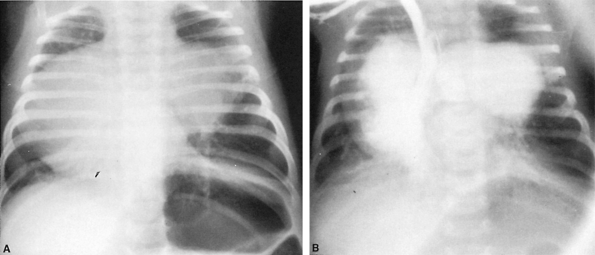 |
Fig. 169-6. A. Chest radiograph of a 2-month-old infant with dextrocardia, ventricular septal defect, and a greatly enlarged pulmonary artery projecting from the mediastinum into the left chest nearly to the lateral chest wall. B. Angiogram of the same patient with injection into the right superior vena cava. The main pulmonary artery is massively enlarged. |
Patients with congenital pulmonary valvular stenosis may develop poststenotic dilatation or aneurysms of the main and left pulmonary arteries from the jet effect of blood on these vessels. Without an associated intracardiac shunt, pulmonary blood flow will be normal. The proximal left pulmonary artery may also become dilated as first described by Gibson and Clifton (1938). The preferential dilatation of the left pulmonary artery is probably related to the direction of the jet into this vessel, because it is a more direct continuation of the pulmonary trunk than is the right branch.
Absence of the pulmonary valve may occur as an isolated anomaly, but is seen more frequently with tetralogy of Fallot, as described by Miller and colleagues (1962). The patients present early in infancy with cyanosis and severe respiratory distress. The regurgitation across the pulmonary annulus causes massive enlargement of the right and left pulmonary arteries, compressing the right and left main-stem bronchi.
P.2529
The pulmonary trunk is large and at fluoroscopy pulsates vigorously. In addition to mediastinal enlargement from the pulmonary arteries, collapse or hyperinflation of the lung may be seen as a result of bronchial compression. These infants require surgical intervention early in life as noted by one of us (ADK) and associates (1999).
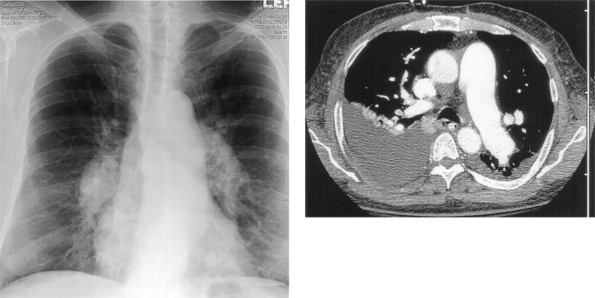 |
Fig. 169-7. A. Chest radiograph demonstrating prominent bilateral hilar densities corresponding to the main pulmonary arteries. This patient has primary pulmonary hypertension. B. Computed tomography of the chest showing a massively dilated left pulmonary artery. Note that the descending pulmonary shunt exceeds the diameter of the aorta. There is also a large right pleural effusion. |
Enlargement of the main pulmonary artery trunk or its branches can be caused by severe chronic pulmonary hypertension of diverse etiology (Fig. 169-7). Unilateral enlargement of the left or right pulmonary artery at the hilus can be caused by a large pulmonary embolism, as first reported by Westermark (1938). This may simulate a perihilar mass. Appropriate history along with a diminution of vascular markings in the ipsilateral lung suggest the diagnosis, which can be confirmed by angiography or dynamic CT.
Anomalous origin of the left pulmonary artery from the right pulmonary artery causes a pulmonary artery sling to be formed, which is the left pulmonary artery coursing around the right main-stem bronchus, between the trachea and esophagus, to the left lung (see Chapter 79 on Vascular Rings). These patients usually present early in life with respiratory distress. A chest radiograph classically shows hyperinflation of the right lung. A mediastinal mass is seen on the lateral chest radiograph between the trachea and esophagus as reported by Jue and colleagues (1965). Barium swallow typically reveals a prominent indentation in the anterior wall of the esophagus immediately above the tracheal bifurcation. Diagnosis is currently made by echocardiography or contrast-enhanced CT scan as reported by Alboliras and associates (1996). The first successful surgical repair of pulmonary artery sling was performed by Potts and colleagues (1954).
Ductus Arteriosus
Aneurysms of the ductus arteriosus present as a rounded mass adjacent to the aortic knob. In the infantile form described by Heikkinen and co-workers (1974), children can present with asphyxia at birth. If the child survives long enough to have a chest radiograph, it will reveal an oval mass with a convex rounded edge projecting from the left superior mediastinum as described by Matisoff and colleagues (1977) (Fig. 169-8). The second type of ductal aneurysm occurs in childhood or early adult life. Aneurysmal enlargement produces respiratory distress due to airway compression or hoarseness due to recurrent laryngeal nerve compression. Long-standing cases may demonstrate progressive enlargement with mural calcification. Surgical excision, according to Cruickshank and Marquis (1958) is warranted owing to the risks of rupture, dissection, endocarditis, and late pulmonary hypertension.
Rare vasculitis such as Beh et's disease, as noted by Schirmer and colleagues (1999), and the Hughes-Stovins syndrome may present with pulmonary artery aneurysms.
Vascular Masses as the Result of Previous Surgical Procedures
There are many causes of mediastinal masses following cardiac surgical procedures for congenital heart disease, particularly if conduits are used. A significant mediastinal mass can be formed by an aneurysm of the right ventricular infundibular patch following repair of tetralogy of Fallot.
P.2530
P.2531
This occurs in about 1% of patients following tetralogy repair. This can be either from a false aneurysm as described by Rosenthal and associates (1972) or thinning of the right ventricular patch, particularly if pericardium is used as noted by Seybold-Epting and co-workers (1977). This appears on the plain chest radiographs as a progressive enlargement of the right ventricular border of the heart, especially on lateral views. Repair should be undertaken expeditiously to prevent risk of rupture.
 |
Fig. 169-8. A. Chest radiograph of an 8-day-old infant with an aneurysm of the ductus arteriosus. Left upper mediastinal mass projects into the left chest. Increased pulmonary blood flow is seen. B. Angiogram shows the ductus aneurysm immediately distal to the left subclavian artery. The preliminary arteries fill via the ductus arteriosus. |
 |
Fig. 169-9. Chest radiographs (posteroanterior and lateral) of a 23-year-old patient with tetralogy of Fallot 16 years after a Potts' (descending aorto-to-pulmonary artery) anastomosis. The left pulmonary artery aneurysm projects from the mediastinum into the left chest (A) and fills the anterior compartment (B). |
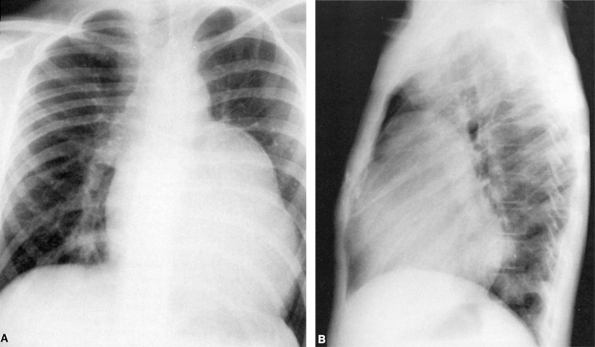 |
Fig. 169-10. Chest radiographs [(posteroanterior (A) and lateral (B)] of a 10-year-old girl with a calcified pulmonary artery aneurysm after a Potts' anastomosis. |
Shunts from the systemic circulation to the pulmonary circulation as palliation for cyanotic heart disease with inadequate pulmonary blood flow can cause aneurysmal dilatation of the pulmonary artery if flow through the shunt is excessive. In particular, the Potts shunt reported by Potts and associates (1946), which was previously used in small babies with inadequate pulmonary blood flow, could cause massive pulmonary artery aneurysms (Fig. 169-9). In some cases the pulmonary artery calcifies, causing a spectacular appearance on chest radiograph (Fig. 169-10). Left pulmonary artery aneurysm formation is one of the reasons the Potts shunt is no longer used.
PULMONARY VENOUS SYSTEM
Pulmonary venous abnormalities causing mediastinal vascular masses include: (a) pulmonary venous confluence, (b) pulmonary venous varix, (c) partial anomalous pulmonary venous connection, and (d) supracardiac (type I) total anomalous pulmonary venous connection as recorded by Cohen and colleagues (1994).
Although variations in the normal pulmonary venous return pattern can cause abnormal mediastinal masses, the most common cause of masses related to these veins is anomalous pulmonary venous connections. In particular, patients with unobstructed anomalous pulmonary venous connections can go for years without symptoms and develop markedly enlarged mediastinal masses.
The variation in normal pulmonary venous return that can cause a mass is when the upper, middle, and lower veins all come together prior to their entry into the left atrium. This has been referred to as a pulmonary venous confluence. Progressing to more unusual configurations, a pulmonary venous varix is a local dilatation of one or more pulmonary veins that have normal return to the left atrium. These generally do not change in diameter over the years, as noted by Ben-Menachem and colleagues (1975), and produce no symptoms.
Partial anomalous pulmonary venous connection on the right side of the mediastinum was reviewed earlier and causes enlargement of the superior vena cava. Partial anomalous pulmonary venous connection on the left side is uncommon. When present, it will appear as an abnormal mediastinal density lateral to the aortic knob, as described by Adler and Silverman (1973).
P.2532
Differentiation from a left superior vena cava is made by the fact that this vein is oriented more obliquely and the superior vena cava more vertically.
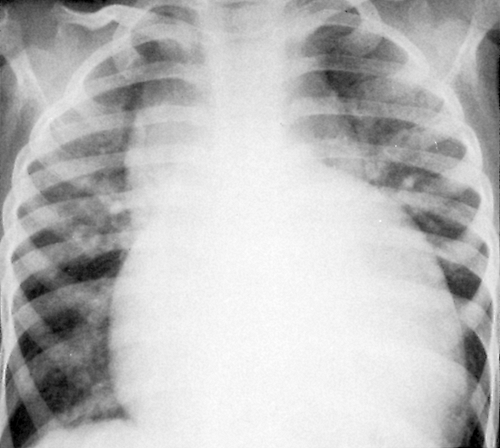 |
Fig. 169-11. A. Chest radiograph of a 4-year-old child with a total anomalous pulmonary venous connection of the supracardiac type. The dilated superior mediastinal structures are the vertical vein on the left and the superior vena cava on the right. Note also cardiomegaly and increased pulmonary blood flow. |
More dramatic chest radiographic findings are seen with total anomalous pulmonary venous connection. Classically, there are three types of total anomalous pulmonary venous connection. Type I is supracardiac, in which the anomalous connection is to a vertical vein on the left side of the mediastinum, which then drains into the innominate vein. The physiologic effect is that of a very large left-to-right shunt. The radiographic presentation is the snowman or figure-of-eight appearance caused by the dilated venous structures in the superior mediastinum (Fig. 169-11). If the veins are partially obstructed, severe symptoms will develop in infancy. If the veins are unobstructed, the patient may go without symptoms (except for cyanosis) for many years, creating a large mediastinal mass (Fig. 169-12). Weaver and colleagues (1976) have called attention to the more subtle finding of a mediastinal density anterior to the trachea, which appears prior to the appearance of the snowman sign. The other types of total anomalous pulmonary venous connection are type II (cardiac) and type III (intracardiac). These types are characterized by slight cardiomegaly with pulmonary venous obstruction, a ground-glass appearance to the lung fields.
MR imaging is useful in depicting partial and total anomalous pulmonary venous connections. In a retrospective review, MR imaging visualized 100% and 96% of all anomalous pulmonary venous connection in the partial and total varieties, respectively.
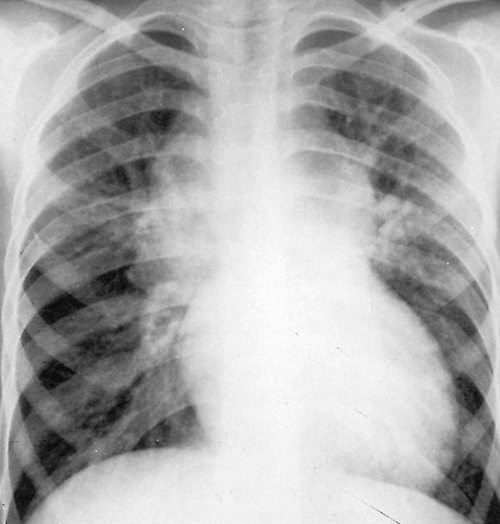 |
Fig. 169-12. Chest radiograph of a more extensive snowman heart in a 13-year-old boy with supracardiac total anomalous pulmonary venous connection. |
SYSTEMIC ARTERIAL SYSTEM
Anomalies of the systemic arterial system that can cause vascular masses in the mediastinum include: (a) diverticula of the left ventricle, (b) aneurysm of the left ventricle, (c) aneurysms of the coronary arteries, (d) aneurysm of the sinus of Valsalva, (e) coronary artery fistula, (f) aortic stenosis, (g) double aortic arch, (h) cervical aortic arch, (i) right aortic arch with Kommerell's diverticulum, (j) anomalous innominate artery, (k) coarctation of the aorta, (l) arteriovenous malformation, and (m) aneurysms of the thoracic aorta and its branches. By far the most common of these in adults are aneurysms or dissections of the ascending or descending aorta (Table 169-5).
Thoracic Aorta and Its Branches
The most common cause of a vascular mediastinal mass in an adult is from an aneurysm of the thoracic aorta. In Lyons' series, 31 of 68 vascular masses were aneurysms in adults, and 37 masses were congenital anomalies more typically found in infants and children. Aneurysms in adults are typically from the aorta or its branches. It is important to recognize that the standard pattern of the thoracic aorta is seen in only 75% of patients. The most common aortic variant is the so-called bovine arch, in which the right brachiocephalic artery and left common carotid artery have a common origin. In the review by Pressler and McNamara (1985) of 260 patients with thoracic aneurysms, 40% of the
P.2533
aneurysms were atherosclerotic, 50% dissecting, and 3% from Marfan's syndrome. Forty percent were located or originated in the ascending aorta, and 60% were located in the descending aorta.
Table 169-5. Causes of Prominent Ascending Aorta or Aortic Arch | |||||||||||||||||
|---|---|---|---|---|---|---|---|---|---|---|---|---|---|---|---|---|---|
|
When initially viewed on the standard radiographs of the chest, aneurysmal lesions of the thoracic aorta may be readily confused with a primary tumor in the visceral compartment of the mediastinum or of the left paravertebral sulcus. The cause of most aneurysms of the descending thoracic aorta is atherosclerosis with resultant weakening and dilatation of the wall of the vessel (Fig. 169-13). Less commonly, congenital defects, bacterial infections, a late false aneurysm from a missed traumatic rupture, or dissection of the descending aorta may be the cause. Takayasu's arteritis and giant cell arteritis are inflammatory processes of the aortic wall that can result in aneurysm formation (Fig. 169-14). Although the aortic arch vessels can be involved with stenoses, involvement of the aorta results in aneurysm formation in 10% of patients. Other forms of aortitis associated with aneurysm formation include lymphoplasmacytic aortitis and aortitis associated with antineutrophil cytoplasmic antibody that was reported by Nakabayashi and associates (2000).
By definition, a true thoracic aortic aneurysm involves all components of the vessel wall. The morphologic subtypes of aneurysms are: (a) saccular, (b) fusiform, (c) dissecting, and (d) false. In addition, acquired aneurysms can be: (a) atherosclerotic, (b) mycotic, (c) posttraumatic, or (d) secondary to cystic medial necrosis. Although aneurysms are more common than dissections within the thoracic aorta, acute aneurysmal rupture is an infrequent occurrence. Initial identification of thoracic aortic aneurysms can be suspected from chest radiographs. Most commonly a mediastinal mass or enlarged segment of the aorta, often containing mural calcification, is visualized. In patients with Marfan's syndrome, an ascending aortic aneurysm may not be seen on chest radiographs because it hides within the cardiac silhouette. Other findings, such as displacement and compression of the esophagus or trachea and bronchi, may be visible. Uncommon findings are erosions of the thoracic vertebrae and posterior ribs.
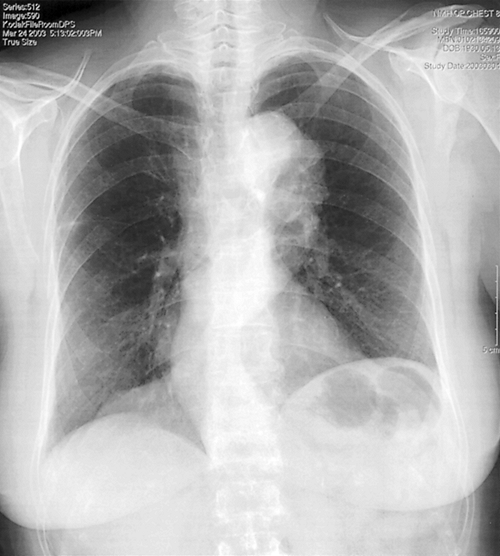 |
Fig. 169-13. Chest radiograph showing enlargement of the left mediastinal silhouette corresponding to a large descending thoracic aortic aneurysm. |
 |
Fig. 169-14. Chest radiograph showing a tortuous, dilatated descending aortic aneurysm from Takayasu's arteritis in a 3-year-old boy. |
P.2534
Contrast-enhanced CT can: (a) show that a mediastinal mass seen on chest radiographs represents an aneurysm, (b) characterize the aneurysm, and (c) reveal the aneurysm's exact location. CT can also be used to ascertain whether the aneurysm affects the takeoff of the arch vessels, the presence of mural thrombus, and calcification within the wall of the aneurysm. CT angiography and MR imaging have made diagnosis and characterization of thoracic aortic aneurysms easier and more accurate. The vascular nature of the mediastinal mass is almost always apparent on CT examination with contrast enhancement. This examination as stressed by Wilkins (personal communication to Thomas Shields, 1990) is considered a must in the evaluation of all visceral mediastinal and paravertebral sulcus lesions.
Aneurysms can project into any of the mediastinal compartments, and their appearance can be dramatic (Fig. 169-15). As noted by Higgins and colleagues (1975), thoracic aortic aneurysms are most commonly located in the descending aorta at the level of the ligamentum arteriosum, just distal to the origin of the left subclavian artery. They are less commonly found within the descending aorta at the level of the aortic hiatus of the diaphragm. The aortic arch is the next most common site, followed by the ascending aorta.
The clinical manifestations of aortic aneurysms vary according to the size and the location of the dilatation. Although aneurysms of the ascending portion often do not cause symptoms, when large enough they can erode the sternum and give rise to a prominent thumping pulsation over the anterior chest wall, thus the designation aneurysms of signs. Aneurysms of the transverse arch tend to compress contiguous structures, resulting in a brassy cough, hemoptysis, hoarseness, and cyanosis of the face and upper extremities, and thus are sometimes referred to as the aneurysm of symptoms. Aneurysms of the descending portion can become very large without causing symptoms.
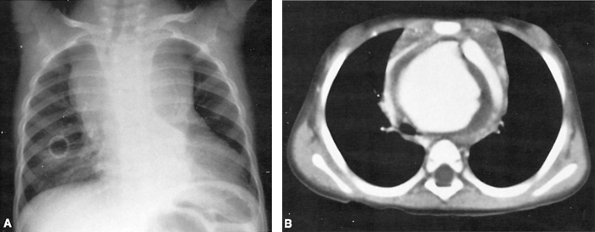 |
Fig. 169-15. A. Chest radiograph shows massive superior mediastinal widening from a false aneurysm at the innominate artery takeoff from the aorta. B. Computed tomography of the same patient shows the descending aorta pushed to the left by the large amount of contrast filling the false aneurysm. |
The presence of a thoracic aortic aneurysm should not be concluded solely from the measurement of aortic circumference. The circumference of the aorta varies significantly according to the size, gender, and age of the patient. For practical purposes, in the diagnosis of a thoracic aortic aneurysm, the descending aorta should never be larger than the ascending aorta at a given scan level, and the ratio of the coronal diameter of the ascending aorta to that of the descending aorta should be about 1.5:1 according to Aronberg and co-workers (1984). The maximum diameter of the aneurysm correlates well with the incidence of rupture. For aneurysms less than 5 cm in diameter, the incidence of rupture is 2%; for aneurysms larger than 10 cm, the incidence of rupture is greater than 50%, as pointed out by Dapunt and associates (1994) as well as by McNamara and Pressler (1978). Up to 50% of deaths from thoracic aortic aneurysms are caused by rupture. A leaking or ruptured thoracic aortic aneurysm creates extensive tissue density from mediastinal hematoma and, occasionally, a left pleural effusion. Most aneurysms are fusiform in configuration, but saccular aneurysms occur in a small percentage of cases. The atherosclerotic aneurysms are most commonly seen arising just below the origin of the left subclavian artery. Rarely, the descending thoracic aorta may be so elongated that it assumes a horizontal position just above the diaphragm and curves sharply to the right and anteriorly, sometimes crossing the midline, appearing as a posterior mediastinal mass. These may extend the entire length of the vessel and involve the abdominal aorta as well. The management of descending aortic aneurysms has been reviewed extensively by Crawford and Crawford (1984), Carlson and associates (1983), and Coselli (1997), among others.
P.2535
Buckling and aneurysm formation of the innominate artery are evident radiographically as a smooth, well-defined opacity in the right superior mediastinal area, extending upward from the aortic arch. Buckling is a relatively common condition that occurs in 15% to 20% of patients with hypertension or atherosclerosis or both, as recorded by Subramanyan and Horii (1984) and Westra (1978). The following pathogenesis has been postulated: The innominate artery is about 5 cm long and is firmly fixed proximally at its origin from the aorta and distally by the subclavian and carotid arteries. When the thoracic aorta elongates and dilates as a result of atherosclerosis, the arch moves cephalad, carrying with it the origin of the innominate artery. Because of its fixation superiorly, the innominate artery buckles to the right. Buckling seldom causes symptoms and is usually innocuous; however, its presence in patients under 30 years of age should suggest the possibility of coarctation of the aorta. Aneurysms of the innominate artery can cause pain, cough, dyspnea, hoarseness, dysphagia, Horner's syndrome, and clubbing of the fingers of the right hand. They may be evidenced by a pulsatile mass at the base of the neck. Kieffer and colleagues (2001) have reported the surgical treatment in 27 patients with good results. However, Conklin and associates (2003) have recorded an erosion into the trachea of an innominate artery graft.
Acute Aortic Dissection
Acute aortic dissection is a true medical emergency that must be recognized accurately and treated promptly, as stressed by Batra (2000) and DeSanctis (1987) and their co-workers. Crawford and associates (1989) have written extensively on this topic. They reviewed 717 patients with aneurysm or dissection of the ascending aorta or transverse aortic arch, or both. The cause was trauma in 6, infection in 20, aortitis in 46, acute dissection in 72, chronic dissection in 189, and medial degeneration in 384 patients. Dissection occurs from a tear in the wall of the aorta with subsequent hemorrhage into the media, creating a second or false lumen. The false lumen is usually located between the inner one third and outer two thirds of the media. According to DeBakey and associates (1982), by far the condition most commonly predisposing to aortic dissection is systemic hypertension. Other, less common, conditions are Marfan's syndrome, Ehlers-Danlos syndrome, syphilis, and coarctation. Aortic dissections have been classified in two ways. The DeBakey classification (1965) subdivides aortic dissection into types, 1, 2, and 3. Type 1 is a dissection starting in the ascending aorta and involving the entire length of the aorta. Type 2 is a dissection limited to the ascending aorta, and type 3 dissection starts distal to the left subclavian artery. The Stanford classification reported by Miller et al (1976) of aortic dissections into two types (types A and B) directly relates to prognosis and therapy and has become more widely accepted as reported by Roberts (1981). Type A dissections involve the ascending aorta, account for 60% to 70% of dissections, and usually arise within a few centimeters of the aortic valve. Type B dissections involve the descending aorta, more commonly arising just distal to the origin of the left subclavian artery near the insertion of the ligamentum arteriosum. These dissections may progress retrograde to involve the arch of the aorta. Figure 169-16 shows the chest radiograph and CT scan of a patient with a type A dissection. Figure 169-17 demonstrates the radiographic and CT scan findings of a patient with a type B dissecting aortic aneurysm.
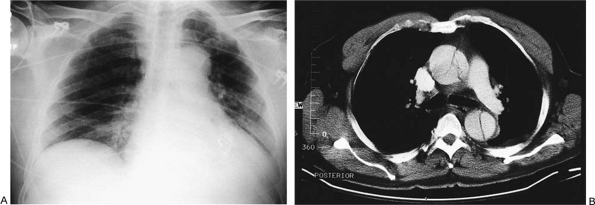 |
Fig. 169-16. A. Chest radiograph of a hypertensive 62-year-old man with previous vague complaints of substernal chest pain and syncope shows a prominent aortic knob and an enlarged left ventricle. B. Acute back pain radiating to the abdomen during hospitalization motivates an emergent computed tomographic scan, which shows a type I dissection in same patient. The enlarged left ventricle was secondary to aortic valve insufficiency. |
Although the findings are nonspecific, chest radiographs in these patients are frequently abnormal. Progressive widening or progressive changes in the configuration of the
P.2536
mediastinum or aorta are highly suspicious for dissection. As with aneurysms, the trachea and esophagus may be displaced. A left pleural effusion, an apical pleural cap, or paraspinal widening may indicate leakage from a dissection. In addition, enlargement of the cardiac silhouette or evidence of acute left heart failure on plain films may indicate acute aortic insufficiency. Echocardiography may reveal a pericardial effusion, indicating leakage from the false lumen and impending rupture into the pericardium. Although found in only a minority of patients, the most specific plain film finding in aortic dissection, as described by Itzchak and co-workers (1975), is displacement of intimal calcification from the outer margin of the aorta by at least 4 to 5 mm. The standard for diagnosis of aortic dissection has long been angiography. However, contrast-enhanced CT scanning and MR imaging, as pointed out by Gilkeson and Kolodny (2003) and by Vogt and associates (2003), provide definitive diagnosis in the majority of cases, making standard angiography unnecessary.
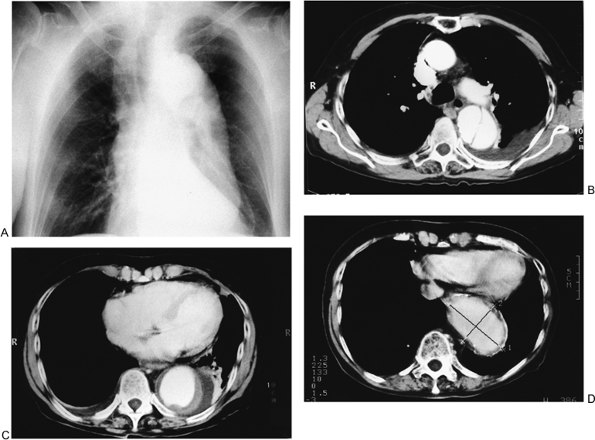 |
Fig. 169-17. A. Chest radiograph of a 78-year-old hypertensive woman presenting with acute onset of sharp back pain and shortness of breath with a widened mediastinum. B D. Serial CT scans demonstrating an ectatic descending thoracic aorta with thrombosed false lumen and type III dissection. |
Chronic Posttraumatic and Postsurgical False Aortic Aneurysms
Chronic posttraumatic false aortic aneurysm or pseudoaneurysms develop in 2% to 5% of patients with undiagnosed acute traumatic aortic injury. Ninety percent of thoracic injuries occur within the proximal descending aorta at the level of the aortic isthmus, immediately distal to the origin of the left subclavian artery and just proximal to the site of attachment of the ligamentum arteriosum. These pseudoaneurysms may present as mediastinal masses on plain films. Moore and colleagues (1984) noted that contrast-enhanced CT or MR imaging reveals the origin of these lesions. Figure 169-18 demonstrates a traumatic pseudoaneurysm of the aortic arch compressing the trachea and resulting in respiratory distress. Postoperative pseudoaneurysms are not uncommon after repair of aortic dissection or aneurysms and should always be considered in any postoperative patient presenting with new symptoms or a mass in the chest or mediastinum on chest radiographs
P.2537
as discussed by Bingley (2000), Katsumata (2000), and Kazui (2001) and their associates.
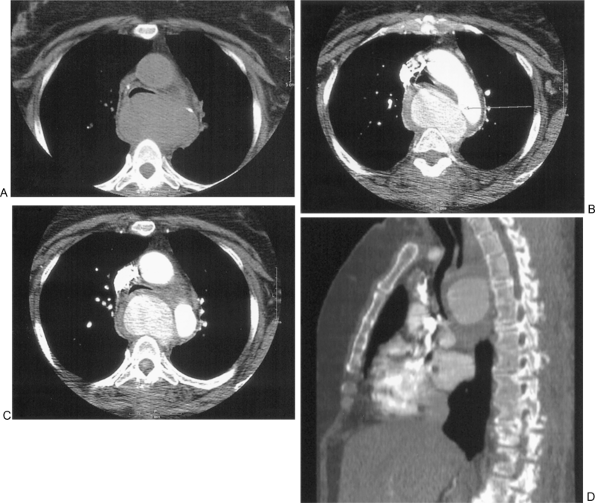 |
Fig. 169-18. Pseudoaneurysm of the ascending aorta. A. Noncontrast computed tomography of the chest demonstrating middle mediastinal mass causing severe compression of the posterior trachea. B. Computed tomography of the chest with contrast demonstrates enhancement of the retrotracheal mass. C. A more superior cut reveals a large pseudoaneurysm of the descending aorta. The arrow points to the neck or origin of the pseudoaneurysm. D. Sagittal reconstruction demonstrates severe posterior tracheal compression by the large pseudoaneurysm. |
Aneurysmal dilatation of a saphenous vein graft also can present as a smooth mediastinal lesion in the paracardiac region as recorded by Gupta and co-workers (2000). Contrast-enhanced CT, MR imaging, or coronary angiography can establish the diagnosis.
Coronary Artery Aneurysms and Coronary Artery Fistulae
Aneurysms of the coronary arteries occur in 1.4% of patients over the age of 16 years. Daoud and colleagues (1963) noted that rupture of a coronary artery aneurysm was the cause of death in 16% of such patients. The left coronary is affected less often than the right according to Syed and Lesch (1997) (Fig. 169-19). Occasionally, these aneurysms become large enough to appear as paracardiac masses and can be associated with the presence of a fistula; Mawatari and associates (2000) recorded successful surgical treatment of such an aneurysm. These aneurysms are predominantly atherosclerotic in nature, although luetic and mycotic causes have been reported. Both saccular and fusiform types have been described by Channon and co-workers (1998). Arterial wall calcification may be present. Although they are most often asymptomatic, surgical correction as recorded by Firstenberg and colleagues (2000) is indicated because of the potential for myocardial infarction, bacterial endarteritis, and rupture.
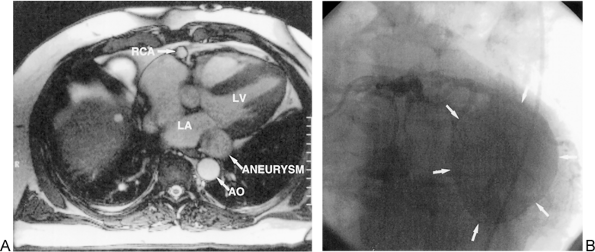 |
Fig. 169-19. A. Computed tomography of the chest demonstrating a large density in the left atrioventricular groove corresponding to an aneurysm of the left coronary artery. RCA, right coronary artery; LA, left atrium; LV, left ventricle; Ao, aorta. B. Coronary angiogram demonstrating a large aneurysm of the left coronary artery. |
P.2538
In children a common cause of coronary aneurysms is Kawasaki's disease as described by Gotteiner and co-workers (2002), as well as by Gersony (1991). In the review by Kato and colleagues (1982), 15% of 290 patients with Kawasaki's disease were diagnosed as having coronary aneurysms. These patients may require internal thoracic artery bypass as described by Mavroudis and associates (1999).
Coronary artery fistula is an uncommon congenital anomaly in which one of the coronary arteries drains directly into a low-pressure cardiac chamber. Ninety-two percent of fistulae empty into the right heart, as reported by Mavroudis and collaborators (1997). In time, the artery becomes tortuous and dilated and can present as a left paracardiac mass, as reported by Castaneda-Zuniga and Amplatz (1977). Coronary angiography and surgical therapy or catheter-based interventions are indicated because these fistulae are predisposed to infection, rupture, and intracardiac shunt formation.
Other Vascular Lesions Presenting as a Mediastinal Mass
Aneurysm of the sinus of Valsalva, which most often involves the noncoronary and the right coronary sinus, can appear as a right paracardiac mass producing a double contour along the superior right atrial border or root of the aorta. The enlarging aneurysm can impinge on the atrioventricular conduction system, resulting in heart block, or it may rupture into the right atrium or right ventricle, producing a clinical picture of aortic regurgitation and left-to-right shunt as described by Naka and associates (2000). The aneurysm is ideally imaged by MR imaging. Curvilinear calcification often occurs in the aneurysm wall.
In infants and children, diverticula of the left ventricle can cause a mediastinal mass to appear along the left heart border, as reported by Davila and associates (1965). Rupture of these diverticula is not uncommon because of the sphincter-like proximal portion that produces high distal pressures. In adults, aneurysm formation of the left ventricular free wall can cause dramatic mediastinal projections, although usually they occur anterolaterally near the left ventricular apex.
Poststenotic dilatation of the ascending aorta from long-standing aortic stenosis can cause a localized bulge in the right perihilar region. This represents either the dilated ascending aorta or the displaced superior vena cava. A clue to the diagnosis, especially in adults, may be calcification in the region of the aortic valve or the aortic knob (Fig. 169-20).
In children, a large number of mediastinal masses are caused by vascular anomalies of the aortic arch system generally referred to as vascular rings, a name coined by Robert Gross (1945). These children generally present with stridor or noisy respiration. The diagnosis can be suspected by abnormalities in the mediastinum on chest radiograph, but as one of us (CLB) and colleagues (1989) pointed out, one may screen for these masses most effectively by barium esophagram. Further evaluation to confirm the precise anatomy can be obtained with contrast-enhanced CT or with magnetic resonance angiography. The location of the aortic arch in relation to the trachea is helpful in determining the type of vascular ring as reported by Bertolini and associates (1987).
P.2539
With a right aortic arch, the aortic knob is absent from its usual location in the left superior mediastinum, and the arch of the aorta projects into the right superior mediastinum. The trachea is deviated to the left, and the superior vena cava to the right. If the location of the aortic arch is not clear and there are small projections on both sides of the mediastinum, a double aortic arch should be suspected (Fig. 169-21). Patients with a right aortic arch may develop a large Kommerell's diverticulum from remnants of the left fourth aortic arch at the origin of the aberrant left subclavian artery, which may require surgical resection with subclavian transfer as reported by one of us (CLB) and colleagues (2002).
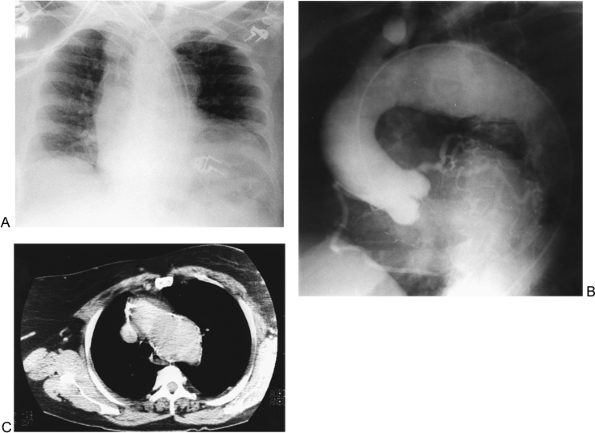 |
Fig. 169-20. A. Chest radiograph of a 70-year-old hypertensive woman complaining of new-onset angina and left scapular pain with a prominent calcified aortic knob. B. Angiogram of the same patient revealing an aneurysm of the distal aortic arch and descending thoracic aorta as well as one-vessel left anterior descending coronary artery disease. C. Computed tomographic scan confirming distal arch involvement with heavy calcification. |
Although not a true vascular ring, the innominate artery, if it originates farther to the left than usual, may compress the anterior trachea and cause clinical symptoms of respiratory distress. This was first reported by Gross and Neuhauser (1948) and can be diagnosed on the chest radiograph as a mediastinal mass indenting the anterior trachea (Fig. 169-22). Confirmation of the syndrome is by bronchoscopy.
The most common aortic arch anomaly is the left aortic arch with aberrant right subclavian artery. The right subclavian artery can arise from a Kommerell's diverticulum. In most cases, the aberrant right subclavian artery crosses posterior to the esophagus, but it courses between the trachea and esophagus in 18% of cases, and in front of the trachea in 4% according to Kalke and co-workers (1987). The common left aortic arch with aberrant right subclavian artery occurs in 1 in 200 patients in the report of Bertolini and associates (1987). In younger patients, it is usually not obvious on chest radiographs. In older patients, however, as noted by Predey and colleagues (1989), it can manifest as a right paratracheal mass or, on the lateral film, as a retrotracheal mass. On CT, the aberrant right subclavian artery arises as the last and most posterior vessel off the aortic arch, crosses the mediastinum behind the trachea and esophagus, and continues into the neck and axilla along the right of the trachea according to Proto and associates (1987). In children, tracheal obstruction or dysphagia rarely occurs, whereas in adults, aneurysms of the aberrant subclavian artery or a prominent Kommerell's diverticulum can occur, resulting in dysphagia as recorded by Austin and Wolfe (1985), as well as by Akers (1991) and Kiernan (1993) and their colleagues. Double aortic arch, the result of persistence of the embryologic double arch, is the most common cause of a symptomatic vascular ring. In double aortic arch, the right arch is generally higher and larger than the left
P.2540
arch. The descending aorta is on the left side in most patients as noted by McLoughlin (1981) and Predey (1989) and their associates. The size of the left arch is quite variable. Double aortic arches typically manifest in infancy with stridor. On CT or MR imaging, the double aortic arch is obvious as two large vascular structures encircling the trachea. Each arch gives rise to a separate subclavian and carotid artery.
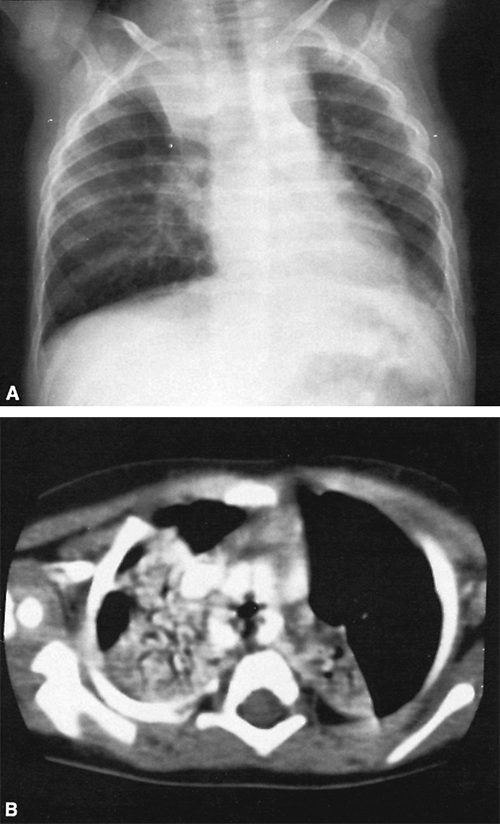 |
Fig. 169-21. A. Chest radiograph in a 7-month-old infant with a double aortic arch. The normal left aortic knob is absent. Atelectasis of the right and left upper lobes of the lung is seen. B. Computed tomography of the same patient shows the trachea and esophagus surrounded by the four components of the ascending and descending left and right arches. The right and left upper lobe atelectasis is prominent. |
A right aortic arch occurs in 0.5% of patients as recorded by Gilkeson and Kolodny (2003). A right aortic is commonly mistaken for a mediastinal mass on chest radiographs, and patients are often referred for CT evaluation of a right paratracheal mass as observed by Baron (1981), McLoughlin (1981), and Predey (1989) and their colleagues. Most asymptomatic adults with a right-sided aortic arch have a left innominate artery. CT or MR imaging easily identifies the aortic arch to the right of the trachea (Fig. 169-23).
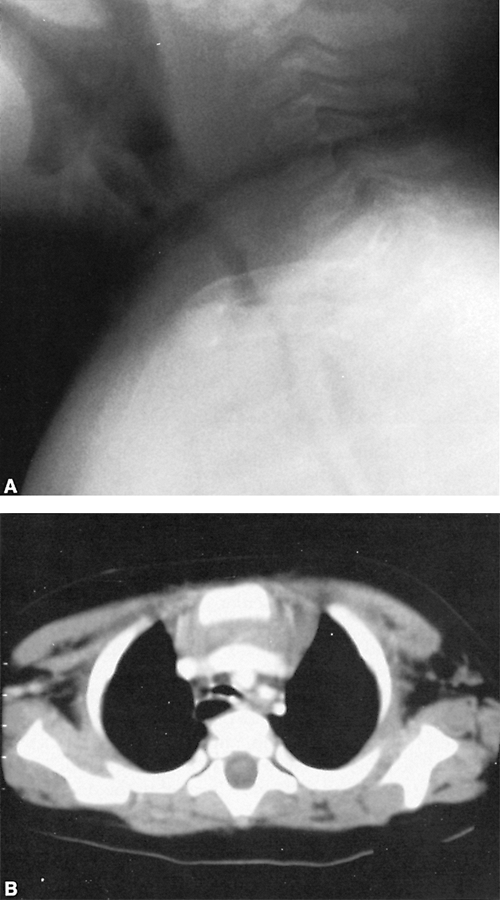 |
Fig. 169-22. A. Lateral neck radiograph show anterior compression of the trachea in a 7-month-old infant girl just at the level of the clavicle. B. Computed tomography shows the three brachiocephalic vessels just below the innominate vein with the innominate artery compressing the anterior wall of the trachea. |
An unusual cause of a superior mediastinal mass is a cervical aortic arch that was reported by Hellenbrand and associates (1978). The cervical aortic arch is an uncommon anomaly of the aorta in which the aortic arch extends into the soft tissues of the neck and can appear as a superior mediastinal mass. Patients with this anomaly are generally asymptomatic, but they can present with dysphagia, stridor, or a pulsatile neck mass (Fig. 169-24). Aneurysms of the cervical arch have been reported by Hirao and co-workers (1999), with several cases of aneurysmal rupture.
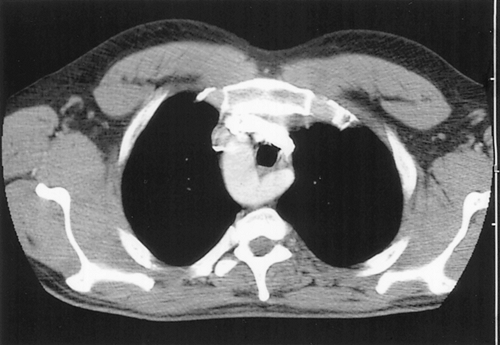 |
Fig. 169-23. Computed tomography of the chest with contrast in a man shows a right aortic arch. |
P.2541
Coarctation of the aorta is a common congenital lesion that may cause a mediastinal vascular mass. Although coarctation of the aorta classically manifests in infants, 20% of patients are diagnosed in adolescence and adulthood. On plain chest radiographs a left superior mediastinal mass may be seen. This represents the dilated left subclavian artery, accentuated by the constriction of the aorta caused by the coarctation just distal to the left subclavian, as noted by Figley (1954) (Fig. 169-25). This is sometimes referred to as the figure 3 sign. In addition, the aorta itself may become aneurysmal just distal to the site of maximal narrowing, and cause a mediastinal mass. Schuster and Gross (1962) reported an overall incidence of aneurysm formation of 10% by the end of the second decade and 20% by the end of the third decade. Aneurysms can also occur following surgical repair of the coarctation (Fig. 169-26). On occasion a retroaortic innominate vein has been associated with coarctation of the aorta, as reported in a review by Konstantinov and associates (2003). Echocardiography and CT have been effective in evaluation of aortic coarctation, but MR imaging is currently regarded as the most effective method to comprehensively assess the anatomy and physiologic significance of aortic narrowing, as suggested by Julsrud and colleagues (1997). MR imaging studies have shown excellent correlation with conventional angiography.
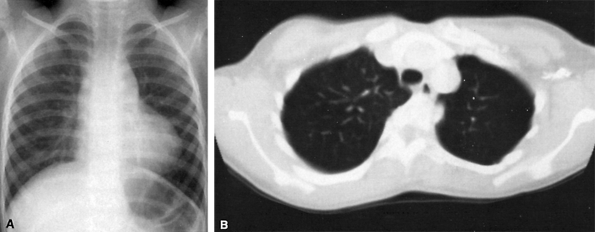 |
Fig. 169-24. A. Chest radiograph shows a wide superior mediastinum with loss of definition of the aortic knob in a patient with a cervical aortic arch. B. Computed tomography shows both the ascending and descending portions of the aortic arch at the level of the innominate vein. |
 |
Fig. 169-25. Chest radiograph showing prestenotic and poststenotic dilatation of the aorta in a 5-year-old boy with coarctation of the aorta (figure-3 sign). |
Pseudocoarctation of the aorta results in a left paramediastinal mass visible just above the aortic knob, caused by elongation and buckling of the aorta without a true pressure gradient. Buckling or kinking of the aortic arch occurs in the region of the ligamentum arteriosum. The bulges represent dilated portions of the aorta just proximal and distal to the kink. The upper bulge is usually higher than the normal aortic knob and can simulate a left superior mediastinal tumor.
 |
Fig. 169-26. A. Chest radiograph of a 7-year-old boy after repair of coarctation of the aorta by resection and end-to-end anastomosis. B. Angiogram of the aorta in the same patient showing a false aneurysm at the site of coarctation repair. |
P.2542
A rare vascular lesion, an aneurysm of a bronchial artery, may present as a mass in the visceral compartment of the mediastinum (Fig. 169-27). The vascular nature of the mass may not be readily appreciated. Wilkins (personal communication to Thomas Shields, 1990) had such a patient but the diagnosis was not established prior to the initial thoracotomy, and excision of the vascular mass could not be performed safely. Postoperative angiography established the diagnosis of a bronchial artery aneurysm. Embolization of the feeding bronchial artery was performed successfully using the balloon occlusion technique described by White (1984). Resection of the aneurysm was subsequently performed without difficulty at a second thoracotomy. This illustrates the necessity for routine CT angiography or MR
P.2543
imaging in the evaluation of mediastinal masses to rule out the possibility of a vascular lesion presenting as a mediastinal tumor.
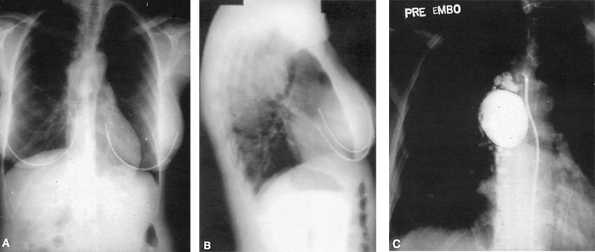 |
Fig. 169-27. A. Posteroanterior chest radiograph revealing a smooth, rounded mass in the upper middle half of the visceral compartment of the mediastinum adjacent to the right side of the trachea. B. Mass shown to distort the trachea anteriorly on the lateral radiograph. Lesion proved to be a vascular mass at thoracotomy. C. Subsequent angiography revealed the mass to be an aneurysm arising from a bronchial artery. Used with permission and courtesy of E.R. Wilkins, Jr. |
Arteriovenous malformations in the mediastinum more often present as retrocardiac mediastinal masses, as noted by Busch (2000) and Lunde (1984) and their co-workers. Vascular tumors of the mediastinum are uncommon and include hemangioma, angiosarcoma, hemangiopericytoma, and lymphangioma. All of these lesions can present as mediastinal masses (see Chapter 192).
REFERENCES
Abbott OA: Congenital aneurysm of superior vena cava: report of 1 case with operative correction. Ann Surg 131:259, 1950.
Adler SC, Silverman JF: Anomalous venous drainage of the left upper lobe. A radiographic diagnosis. Radiology 108:563, 1973.
Akers DL Jr, et al: Complications of anomalous origin of the right subclavian artery: case report and review of the literature. Ann Vasc Surg 5: 385, 1991.
Alboliras ET, et al: Pulmonary artery sling: diagnostic and management strategy. Pediatrics 98:530A, 1996.
Anderson RC, Adams P, Burke B: Anomalous inferior vena cava with azygos continuation: infrahepatic interruption of the inferior vena cava. J Pediatr 59:370, 1961.
Aronberg DJ, et al: Normal thoracic aortic diameters by computed tomography. J Comput Assist Tomogr 8:247, 1984.
Austin EH, Wolfe WG: Aneurysm of aberrant subclavian artery with a review of the literature. J Vasc Surg 2:571, 1985.
Backer CL, et al: Vascular anomalies causing tracheoesophageal compression. Review of experience in children. J Thorac Cardiovasc Surg 97: 725, 1989.
Backer CL, et al: Resection of Kommerell's diverticulum and left subclavian artery transfer for recurrent symptoms after vascular ring division. Eur J Cardiothorac Surg 22:64, 2002.
Baron RL, et al: CT of anomalies of the mediastinal vessels. AJR 137:571, 1981.
Batra P, et al: Pitfalls in the diagnosis of thoracic aortic dissection at CT angiography. Radiographics 20:309, 2000.
Bell MJ, Gutierrez JR, DuBois JJ: Aneurysm of the superior vena cava. Radiology 95:317, 1970.
Ben-Menachem Y, et al: The various forms of pulmonary varices. Report of three cases and review of the literature. Am J Roentgenol Radium Ther Nucl Med 125:881, 1975.
Bertolini A, et al: Vascular rings and slings. Diagnosis and surgical treatment of 49 patients. J Cardiovasc Surg (Torino) 28:301, 1987.
Bingley JA, et al: Late complications of tissue glues in aortic surgery. Ann Thorac Surg 69:1764, 2000.
Bousmara M II, et al: Vascular lesions of the mediastinum. Chest Surg Clin North Am 2:57, 1992.
Bozkurt AK, et al: Multiple pulmonary artery aneurysms due to infective endocarditis. Ann Thorac Surg 75:593, 2003.
Busch T, et al: Retrocardiac arteriovenous malformation causing recurrent cerebral ischemia. Ann Thorac Surg 70:663, 2000.
Caramutti VM, et al: Azygos vein diverticulum. Ann Thorac Surg 70:665, 2000.
Carlson DE, Karp RB, Kouchoukos NT: Surgical treatment of aneurysms of the descending thoracic aorta: an analysis of 85 patients. Ann Thorac Surg 35:58, 1983.
Castaneda-Zuniga WR, Amplatz K: Coronary artery fistula seen as a mediastinal mass. Radiology 123:568, 1977.
Cha EM, Khoury GH: Persistent left superior vena cava. Radiologic and clinical significance. Radiology 103:375, 1972.
Channon KM, Wadsworth S, Bashir Y: Giant coronary artery aneurysm presenting as a mediastinal mass. Am J Cardiol 82:1307, 1998.
Cohen MC, Hartnell GG, Finn JP: Magnetic resonance angiography of congenital pulmonary vein anomalies. Am Heart J 127:954, 1994.
Cole TJ, et al: Normal and abnormal vascular structures that simulate neoplasms on chest radiographs: clues to the diagnosis. Radiographics 15: 867, 1995.
Conklin LD, et al: Tracheal erosion by an innominate artery graft: presentation and surgical repair. Ann Thorac Surg 75:573, 2003.
Cormier MG, et al: Congenital anomalies of the superior vena cava: a CT study. Semin Roentgenol 24:77, 1989.
Coselli JS: Descending and thoracoabdominal aortic aneurysms. In Edmunds LH Jr, (ed): Cardiac Surgery in the Adult. New York: McGraw-Hill, 1997.
Crawford ES, Crawford JL: Diseases of the Aorta: Including an Atlas of Angiographic Pathology and Surgical Technique. Baltimore: William & Wilkins, 1984.
Crawford ES, et al: Surgical treatment of aneurysm and/or dissection of the ascending aorta, transverse aortic arch, and ascending aorta and transverse aortic arch. Factors influencing survival in 717 patients. J Thorac Cardiovasc Surg 98:659, 1989.
Cruickshank B, Marquis RM: Spontaneous aneurysms of the ductus arteriosus. Am J Med 25:140, 1958.
Daoud AS, et al: Aneurysms of the coronary artery: report of ten cases and review of the literature. Am J Cardiol 11:228, 1963.
Dapunt OE, et al: The natural history of thoracic aortic aneurysms. J Thorac Cardiovasc Surg 107:1323, 1994.
Davila JC, et al: Congenital aneurysm of the left ventricle. Ann Thorac Surg 1:697, 1965.
DeBakey ME, et al: Surgical management of dissecting aneurysm of the aorta. J Thorac Cardiovasc Surg 49:130, 1965.
DeBakey ME, et al: Dissection and dissecting aneurysms of the aorta: twenty-year follow-up of five hundred twenty-seven patients treated surgically. Surgery 92:1118, 1982.
DeSanctis RW, et al: Aortic dissection. N Engl J Med 317:1060, 1987.
Dodge-Khatami A, et al: Complete repair of tetralogy of Fallot with absent pulmonary valve including the role of airway stenting. J Card Surg 14: 82, 1999.
Dudiak CM, Olson MC, Posniak HV: Abnormalities of the azygos system: CT evaluation. Semin Roentgenol 24:47, 1989.
Dudiak CM, Olson MC, Posniak HV: CT evaluation of congenital and acquired abnormalities of the azygos system. Radiographics 11:233, 1991.
Figley M: Accessory roentgen signs of coarctation of the aorta. Radiology 62:671, 1954.
Firstenberg MS, et al: Interposition vein graft for giant coronary aneurysm repair. Ann Thorac Surg 70:1397, 2000.
Freedom RM, Treves S: Splenic scintigraphy and radionuclide venography in the heterotaxy syndrome. Radiology 107:381, 1973.
Gersony WM: Diagnosis and management of Kawasaki disease. JAMA 265:2699, 1991.
Gibson S, Clifton WM: Congenital heart disease. Am J Dis Child 55:761, 1938.
Gilkeson RC, Kolodny S: Computed tomography and magnetic resonance imaging of the thoracic aorta. In Hagga JR, Lanziere CF, Gilkeson RC (eds): CT and MR Imaging of the Whole Body. 4th Ed. St. Louis: CV Mosby, 2003.
Gotteiner N, et al: Coronary artery bypass grafting for Kawasaki disease. Pediatr Cardiol 23:62, 2002.
Gross RE: Surgical relief for tracheal obstruction from a vascular ring. N Engl J Med 233:586, 1945.
Gross RE, Neuhauser EBD: Compression of the trachea by an anomalous innominate artery. Am J Dis Child 75:570, 1948.
Gupta S, et al: Clinical conference on management dilemmas: a growing vascular mass in the chest. Chest 118:1769, 2000.
Hartnell GG: Magnetic resonance angiography of systemic thoracic and abdominal veins. Magn Reson Imaging Clin North Am 1:281, 1993.
Hartnell GG, et al: Magnetic resonance angiography of the central chest veins: a new gold standard? Chest 107:1053, 1995.
Haswell DM, Berrigan TJ: Anomalous inferior vena cava with accessory hemi azygos continuation. Radiology 119:51, 1976.
Heikkinen E, et al: Infantile aneurysm of the ductus arteriosus. Diagnosis, incidence, pathogenesis, and prognosis. Acta Pediatr Scand 63:241, 1974.
Heitzman ER: Radiologic appearance of the azygos vein in cardiovascular disease. Circulation 47:628, 1973.
Hellenbrand WE, et al: Cervical aortic arch with retroesophageal aortic obstruction: report of a case with successful surgical intervention. Ann Thorac Surg 26:86, 1978.
P.2544
Higgins CB, et al: Localised aneurysms of the descending thoracic aorta. Clin Radiol 26:474, 1975
Hirao K, et al: The cervical aortic arch with aneurysm formation. J Comput Assist Tomogr 23:959, 1999.
Itzchak Y, et al: Dissecting aneurysm of the thoracic aorta: reappraisal of radiologic diagnosis. Am J Roentgenol Radium Ther Nucl Med 125: 559, 1975.
Joseph AE, Donaldson JS, Reynolds MR: Neck and thorax venous aneurysm: association with cystic hygroma. Radiology 170:109, 1989.
Jue KL, et al: Anomalous origin of the left pulmonary artery from the right pulmonary artery: report of 2 cases and review of the literature. Am J Roentgenol Radium Ther Nucl Med 95:598, 1965.
Julsrud PR, et al: Coarctation of the aorta: collateral flow assessment with phase-contrast MR angiography. AJR 169:1735, 1997.
Kalke BR, Magotra R, Doshi SM: A new surgical approach to the management of symptomatic aberrant right subclavian artery. Ann Thorac Surg 44:86, 1987.
Kato H, et al: Fate of coronary aneurysms in Kawasaki disease: serial coronary angiography and long-term follow-up study. Am J Cardiol 49: 1758, 1982.
Katsumata T, et al: Mediastinal false aneurysm after thoracic aortic surgery. Ann Thorac Surg 70:547, 2000.
Kazui T, et al: Role of biologic glue repair of proximal aortic dissection in the development of early and midterm redissection of the aortic root. Ann Thorac Surg 72:509, 2001.
Kelley MJ, Mannes EJ, Ravin CE: Mediastinal masses of vascular origin. A review. J Thorac Cardiovasc Surg 76:559, 1978.
Kieffer E, et al: Aneurysms of the innominate artery: surgical treatment of 27 patients. J Vasc Surg 34:222, 2001.
Kiernan PD, et al: Aneurysm of an aberrant right subclavian artery: case report and review of the literature. Mayo Clin Proc 68:468, 1993.
Konstantinov IE, et al: Retroaortic innominate vein with coarctation of the aorta: surgical repair and embryology review. J Thorac Cardiovasc Surg 75:1014, 2003.
Lunde P, et al: Huge arteriovenous malformation in the mediastinum. Clinical presentation and surgical management. Scand J Thorac Cardiovasc Surg 18:75, 1984.
Lyons HA, Calvy FL, Sammons BP: The diagnosis and classification of mediastinal masses. A study of 782 cases. Ann Intern Med 51:897, 1959.
Matisoff DN, et al: Superior mediastinal mass in a neonate. Chest 71:205, 1977.
Mavroudis C, et al: Coronary artery fistulas in infants and children: a surgical review and discussion of coil embolization. Ann Thorac Surg 63:1235, 1997.
Mavroudis C, et al: Pediatric coronary artery bypass for Kawasaki congenital, post arterial switch, and iatrogenic lesions. Ann Thorac Surg 68: 506, 1999.
Mawatari T, et al: Successful surgical treatment of giant coronary artery aneurysm with fistula. Ann Thorac Surg 70:1394, 2000.
McAdams HP, et al: Mediastinum. In Hagga JR, Lanziere CF, Gilkeson RC (eds): CT and MR Imaging of the Whole Body. 4th Ed. St. Louis: CV Mosby, 2003.
McLoughlin MJ, et al: Computed tomography in congenital anomalies of the aortic arch and great vessels. Radiology 138:399, 1981.
McNamara JJ, Pressler VM: Natural history of arteriosclerotic thoracic aneurysm. Ann Thorac Surg 26:468, 1978.
Miller DC, et al: Operative treatment of aortic dissections. Experience with 125 patients over sixteen-year period. J Thorac Cardiovasc Surg 78:365, 1979.
Miller RA, Lev M, Paul MH: Congenital absence of the pulmonary valve. The clinical syndrome of tetralogy of Fallot levity pulmonary regurgitation. Circulation 26:266, 1962.
Moore EH, et al: MRI of chronic posttraumatic false aneurysms of the thoracic aorta. AJR 143:1195, 1984.
Naka Y, et al: The long-term outcome of a surgical repair of sinus of Valsalva aneurysm. Ann Thorac Surg 70:727, 2000.
Nakabayashi K, Kamiya Y, Nagasawa T: Aortitis syndrome associated with positive perinuclear antineutrophil cytoplasmic antibody: report of three cases. Int J Cardiol 75:S89, 2000.
Potts WJ, Smith S, Gibson S: Anastomosis of the aorta try a pulmonary artery for certain types of congenital heart disease. JAMA 132:627, 1946.
Potts WJ, Holinger PH, Rosenblum AH: Anomalous left pulmonary artery causing obstruction to right main bronchus: report of a case. JAMA 155: 1409, 1954.
Predey TA, et al: CT of congenital anomalies of the aortic arch. Semin Roentgenol 24:96, 1989.
Pressler V, McNamara JJ: Aneurysm of the thoracic aorta. Review of 260 cases. J Thorac Cardiovasc Surg 89:50, 1985.
Proto AV, Cuthbert NW, Raider L: Aberrant right subclavian artery: further observations. AJR 148:253, 1987.
Quaegebeur J, et al: Surgical experience with unroofed coronary sinus. Ann Thorac Surg 27:418, 1979.
Roberts WC: Aortic dissection: anatomy, consequences, and causes. Am Heart J 101:195, 1981.
Rosenthal A, Gross RE, Pasternac A: Aneurysms of right ventricular outflow patches. J Thorac Cardiovasc Surg 63:735, 1972.
Schirmer M, Calamia KT, O'Duffy JD: Is there a place for large vessel disease in the diagnostic criteria of Beh et's disease? J Rheumatol 26:2511, 1999.
Schuster SR, Gross RE: Surgery for coarctation of the aorta: a review of 500 cases. J Thorac Cardiovasc Surg 43:54, 1962.
Seebauer L, et al: A mediastinal tumor simulated by a sacculated aneurysm of the azygos vein. J Thorac Cardiovasc Surg 37:112, 1989.
Seybold-Epting W, et al: Aneurysm of pericardial right ventricular outflow tract patches. Ann Thorac Surg 24:237, 1977.
Subramanyan BR, Horii SC: Sonographic demonstration of buckling of the great vessels of the neck. AJR 142:1111, 1984.
Syed M, Lesch M: Coronary artery aneurysm: a review. Prog Cardiovasc Dis 40:77, 1997.
Vogt FM, Goyen M, Debatin JF: MR angiography of the chest. Radiol Clin North Am 41:29, 2003.
Weaver MD, et al: Total anomalous pulmonary venous connection to the left vertical vein. A plain-film sign useful in early diagnosis. Radiology 118:679, 1976.
Webb WR, et al: Computed tomographic demonstration of mediastinal venous anomalies. AJR 139:157, 1982.
Westermark N: On the roentgen diagnosis of lung embolism. Acta Radiol 19:357, 1938.
Westra D: Vascular pseudo-tumours of the mediastinum in asymptomatic patients: a tomographic study. 1. Arteries. Radiol Clin (Basel) 47:100, 1978.
White CS: MR imaging of thoracic veins. Magn Reson Imaging Clin North Am 8:17, 2000.
White CS, et al: MR imaging of congenital anomalies of the thoracic veins. Radiographics 17:595, 1997.
White RI Jr: Embolotherapy in vascular disease. AJR 142:27, 1984.
Wood P: Pulmonary hypertension. Med Con Cardiovasc Dis 28:513, 1959.
EAN: 2147483647
Pages: 203